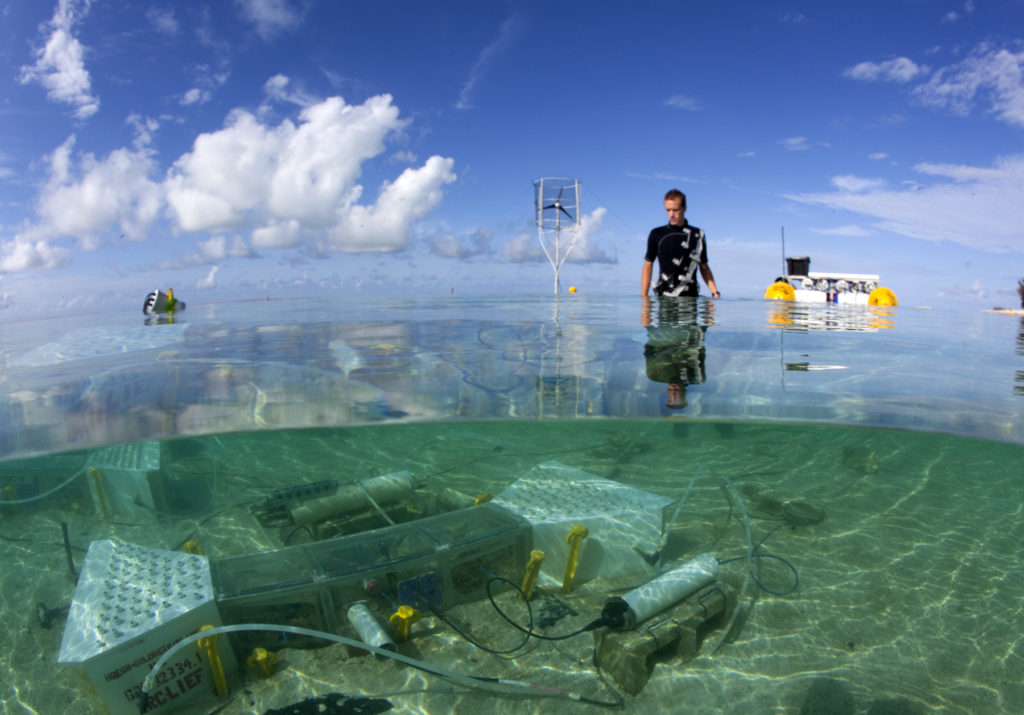Posted on Peninsula Press: 15 May 2013 — By Anna Hallingstad

This device, the brainchild of David Kline and the Monterey Bay Aquarium Research Institute, is a minilab that helps researchers determine the effects climate change has on coral reefs. (Photo courtesy of David Kline, Scripps Institution of Oceanography)
Picture a tropical paradise and you might conjure something like Heron Island, Australia. Two hours by catamaran from the town of Gladstone, Queensland, the sandy island’s 40 acres are shared by a resort, a scientific research station, and thousands of black noddies, a dusky and talkative seabird that nests in the lime-green pisonia trees each austral spring.
Just beyond the white sand beach, however, is where Heron Island’s true treasure lies—a treasure in danger of melting away. The coral reef at Heron Island lies within the Great Barrier Reef Marine Protected Area, meaning that its 900-some fish species and more than 300 coral species are safeguarded from common reef-killers like overfishing, dynamiting and sediment runoff. But in the last decade, a new adversary has entered the ring: ocean acidification.
Caused by the same carbon dioxide emissions as climate change, this coral-corroding drop in seawater pH may be just as far-reaching as its climate counterpart, and just as hard to study in a laboratory—until now. Stanford researchers have joined Australian scientists on Heron Island to try out a new way of looking at acid-addled corals. And it just might be a big step in the right direction for reef survival.
Ocean acidification expert Richard Feely, of the National Oceanographic and Atmospheric Administration (NOAA), calls it “global warming’s evil twin.” Feely and other scientists fear this growing acidification, which was discovered in 2003, is already dissolving the shells and skeletons of creatures like corals, oysters and starfish. As these fears play out, the loss of coral reefs could mean a big-time loss to people: according todata cited by NOAA, the economic value of coral reefs—from tourism, fisheries, and coastal protection, among other services—is nearly $30 billion per year.
With stakes this high, scientists need the right information to place their bets right—in this case, to focus conservation efforts where they will do the most good. Unfortunately, this information has been hard to come by. Ocean acidification research has been hampered by the difficulty of keeping the experiments realistic. Feely lamented at a 2011 talk at the University of Washington, “Our present understanding [of ocean acidification] is from very simplistic experiments: usually short durations, with single species, under very short incubation periods—usually two weeks, three weeks—and extreme pH changes.“
But researchers from Stanford University, the University of Queensland, and elsewhere have invented a new technique that knocks these shortcomings out—and then some. How? By bringing the lab to the reef.
It’s called the Coral Proto Free Ocean Carbon Enrichment system, or CP-FOCE. The brainchild of project leader David Kline (then at UQ, now at the Scripps Institution of Oceanography) and the Monterey Bay Aquarium Research Institute, CP-FOCE is a mini lab that researchers floated out to the reef and anchored on the sandy bottom. They made three copies of the device for the Heron Island experiment, each with a meter-long, clear plastic chamber, open on the bottom so creatures residing in the sand could interact normally with whatever else was inside.
Read the rest of the story on Peninsula Press.